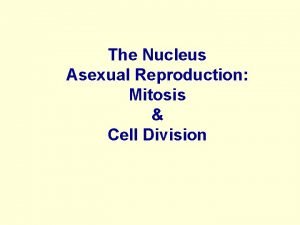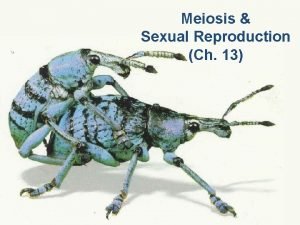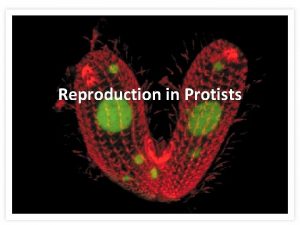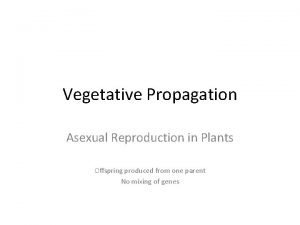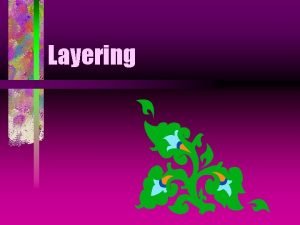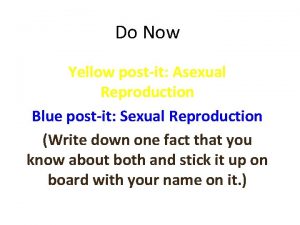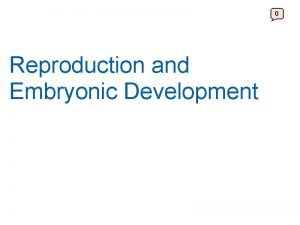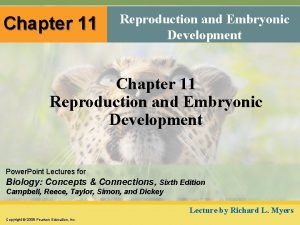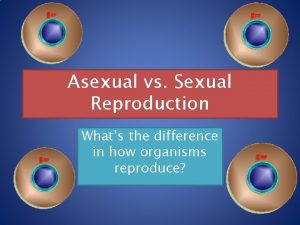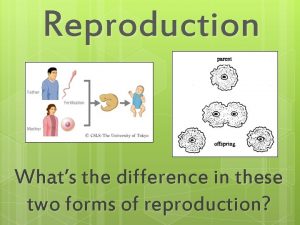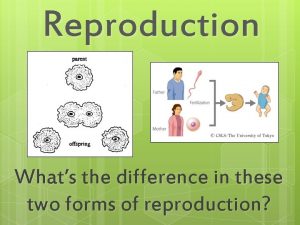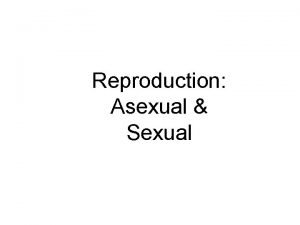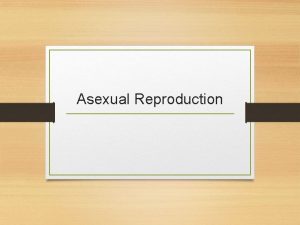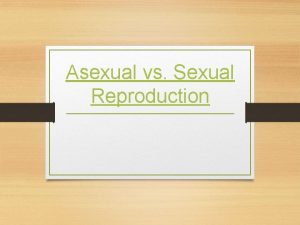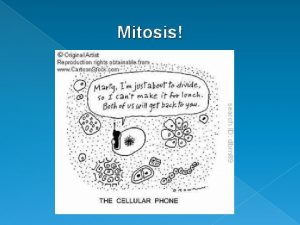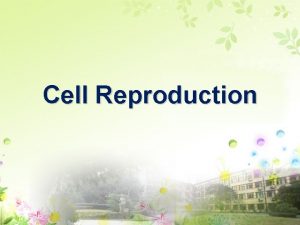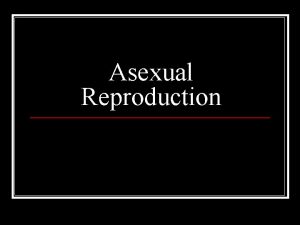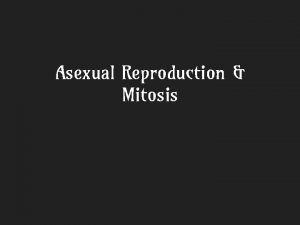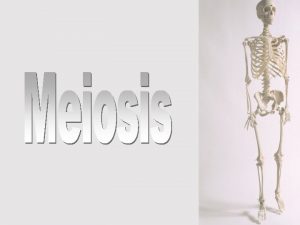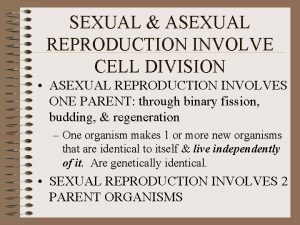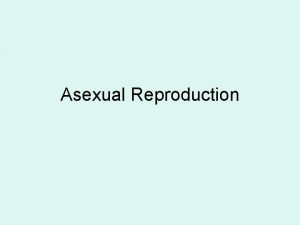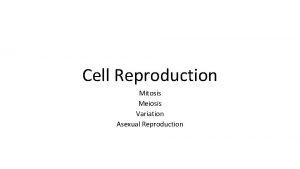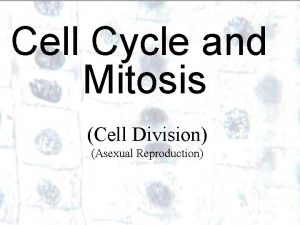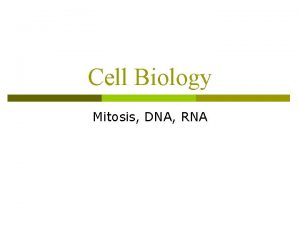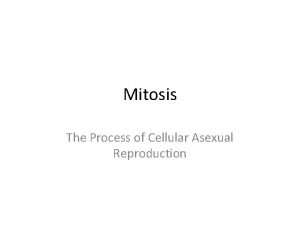Asexual Reproduction aka MITOSIS In asexual reproduction cell






















- Slides: 22

Asexual Reproduction aka MITOSIS! • In asexual reproduction, cell division results in 2 identical “daughter” cells being produced from a “parent” parent cell • Each human cell has 46 chromosomes in its nucleus

Cell Cycle - Mitosis • 10% of cell life cycle • The cell undergoes cell division In humans, millions of cells divide every second to maintain a total of ~60 trillion cells, 6. 0 x 10 13 - some divide once a day (skin & hair and stomach) and some not at all (nerve & muscle cells)

Mitosis Stages Mitosis is a continual process, but we divide it into 4 phases Mitosis phases: 1. Prophase 2. Metaphase 3. Anaphase 4. Telophase

1. Prophase -chromatin condenses into distinct duplicated chromosomes -Nuclear membrane begins to disintegrate -In animal cells organelles called centrioles move to opposite sides of the cell (“poles”) -Astral rays (microtubles) form around centrioles

Be sure to label: 1. Sister chromatids/ chromosomes 2. Centrioles 3. Astral rays 4. Nuclear memebrane Draw a prophase diagram Centrioles Astral Rays Made of 2 sister chromatids, attached by a centromere Nuclear membrane disintegrates

Early Prophase

Late Prophase

Step 2: Metaphase -Chromosomes line up at equator and centromere attaches to spindle fibers At the end of this phase the centromere splits separating the sister chromatids Nuclear membrane disappears

Draw a diagram Be sure to label: 1. Centromere 2. Equatorial plate Centromere 3. Spindle fibers 4. Centriole Spindle Fibres Centrioles Equatorial Plate

METAPHASE

Metaphase: Spindle Fibers

Step 3: Anaphase -The spindle fibers contract, pulling the chromosomes (sister chromatids) to the opposite poles of the cell -Centromeres divide

Draw a diagram Be sure to include: 1. 2. 3. 4. Sister chromatids Spindle fibres Centromere Centrioles Centromere is split

ANAPHASE

Step 4: Telophase - Chromatids reach opposite poles; spindle and astral rays disappear - Chromosomes unwind back into chromatin - Nuclear membrane begins to reform - Cell membrane pinches in the middle to begin Cytokinesis

Draw a diagram • Be sure to liable: Part A: • Cleavage furrow Daughter cells • Nuclear membrane Part B: • Daughter cells • Nuclear membrane Nuclear • Chromatin membrane Chromatin

TELOPHASE

INTERPHASE PROPHASE

METAPHASE ANAPHASE Metaphase plate Spindle Daughter chromosomes TELOPHASE & CYTOKINESIS Cleavage furrow Nuclear envelope forming Nucleolus forming

Interphase Metaphase Prophase Anaphase Metaphase Telophase

Animals Versus Plants There are 2 main differences in cell division 1. Plants do not contain centrioles - They contain microtubules that create many of the same proteins (spindles), they just don’t have the centrioles 2. Plants do not undergo cytokinesis - Instead a cell plate forms at the equator of the cell to form a new cell wall

Cytokinesis • Animal Cytokinesis Cleavage furrow Cell Plate Plant
 Sexual and asexual reproduction venn diagram
Sexual and asexual reproduction venn diagram Hare lynx
Hare lynx Asexual and sexual reproduction venn diagram
Asexual and sexual reproduction venn diagram Sexual and asexual reproduction
Sexual and asexual reproduction Is mitosis asexual
Is mitosis asexual Is mitosis asexual
Is mitosis asexual Reproduction of protists
Reproduction of protists Vegetative propagation
Vegetative propagation Fission vs budding
Fission vs budding Platyhelminthes examples
Platyhelminthes examples Budding asexual reproduction
Budding asexual reproduction Asexual propagation examples
Asexual propagation examples Layering asexual reproduction
Layering asexual reproduction What animal is asexual
What animal is asexual Asexual reproduction
Asexual reproduction Asexual reproduction
Asexual reproduction Whats sexual reproduction
Whats sexual reproduction Sexual reproduction
Sexual reproduction Chapter 19 asexual reproduction answer key
Chapter 19 asexual reproduction answer key Mitosis vs meiosis chart
Mitosis vs meiosis chart Whats asexual reproduction
Whats asexual reproduction Whats asexual reproduction
Whats asexual reproduction Asexual vs sexual reproduction
Asexual vs sexual reproduction




